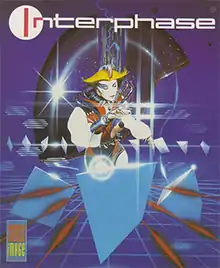Interphase (video game)
Interphase is a 1989 3D first-person and puzzle video game developed by The Assembly Line and published by Image Works for multiple platforms.
| Interphase | |
|---|---|
 Cover art for Interphase | |
| Developer(s) | The Assembly Line |
| Publisher(s) | Image Works |
| Designer(s) | Dean Lester, Danny Emmett[1] |
| Programmer(s) | Adrian Stephens[1] |
| Platform(s) | Atari ST, DOS, Amiga |
| Release | 1989 |
| Genre(s) | 3D shooter and puzzle |
The developers were licensed to use concepts from Neuromancer, reflected in the virtual-reality cyberspace concept and theme of a powerful corporation.
The game is considered an early first-person shooter, pre-dating Catacomb 3-D and Wolfenstein 3D. However, the game primarily focuses on puzzle-solving using the interaction between a 3D cyberpunk environment and its conceptual relationship with a 2D zoomable blueprint in which a non-player character is indirectly guided through the floors of a high-security building.
Later games that have a similar style to the 3D elements in Interphase include Pyrotechnica and Rez.
Storyline
In the future, automation of most jobs has led to boredom, which in turn has led to a boom in the leisure industry. DreamTracks, created by Dreamers who work for multi-national corporations, are recorded patterns of imagination. The general public then view these DreamTracks as a form of entertainment.[1]
The player, Chad a Dreamer discovers that subliminal messages are being inserted into DreamTracks to persuade consumers to buy certain products[2] and more worryingly, to push certain political viewpoints and pro-government propaganda.[3]
Using a human to computer interface, known as an Interphase[3][4], Chad sets out to destroy a particularly dangerous DreamTrack stored in a high security building. He has asked his girlfriend, Kaf-E[4] to physically break into the building while he virtually infiltrates the computer to disable computer controlled defences and security systems.[5]
Gameplay
The action mostly takes place in two modes: a 3D cyberpunk environment and a 2D schematic map where puzzles are encountered. 3D objects in the cyberpunk environment represent objects such as security doors and cameras. To disable the real-world devices, the 3D objects must be destroyed. Puzzle-solving involves determining which objects to disable and in what order. The player must also deal with virtual defences, represented by enemy ships which pose a threat to the player's ability to jack in to the system, and which must be defeated.
While viewing the 2D schematic, the action in the 3D world continues, so it's essential that enemy ships have been dispensed with before puzzle-solving can proceed. Otherwise, the player becomes a sitting duck.
The player controls Chad in the 3D section of the game while in the 2D section Kaf-E follows a path throughout the building and attempts to reach the lift to the next level, messaging Chad if she encounters an obstacle or notices something that could assist. The player's main goal is to disable/manipulate the real world objects and security to allow Kaf-E to progress safely without getting killed by traps or caught by the security bots, as well as ensuring his virtual craft is not destroyed by the defenses. Allowing either his own craft to be destroyed or Kaf-E's safety compromised will result in a game over.
The game was ranked the 38th best game of all time by Amiga Power.[6]
Graphical style
.png.webp)
The 2D environment is a polygon-based schematic closely resembling an animated blueprint. A very deep zoom-in is possible and necessary. The progress of Kaf-E and the positions of moving objects (e.g., security guards) and fixed objects such as cameras can all be monitored in this view.
The 3D environment is a first-person view from the front of a virtual ship navigating a multiple-level environment. The virtual levels do not represent the floors of the building, they simply represent parts of the computer system. Navigation between levels is accomplished by flying through square panels.
See also
References
- McCandless, David (November 1989). Zero Magazine Issue 01, November 1989. pp. 46–49.CS1 maint: date and year (link)
- Zzap! 64 Issue 056 (HQ).
- Zero_Issue_02_Dec_89.
- "Interphase - Manual, Docs, Documentation - Lemon Amiga". www.lemonamiga.com. Retrieved 2019-06-02.
- The Games Machine Magazine Issue 25. December 1989.
- Amiga Power magazine issue 0, Future Publishing, May 1991